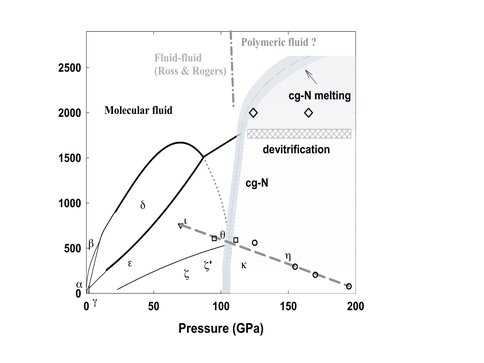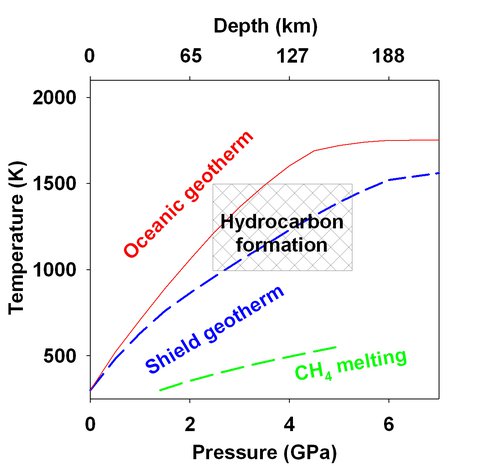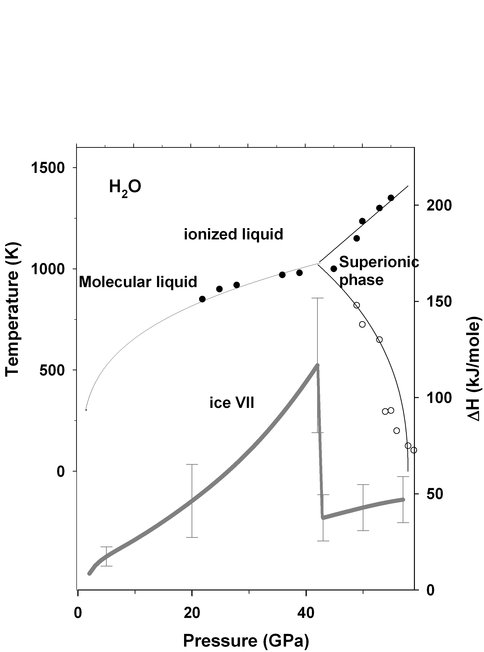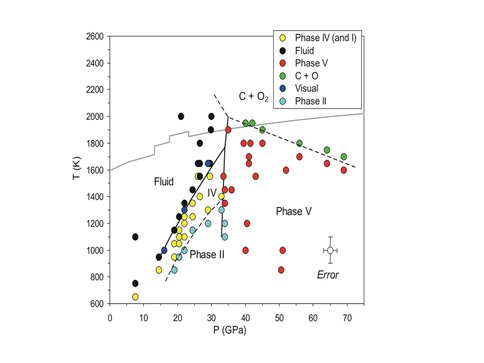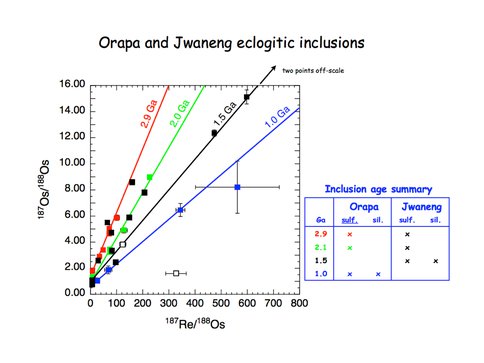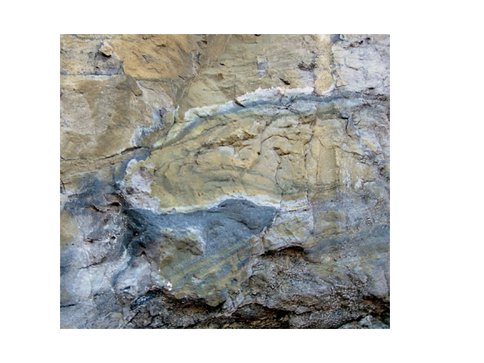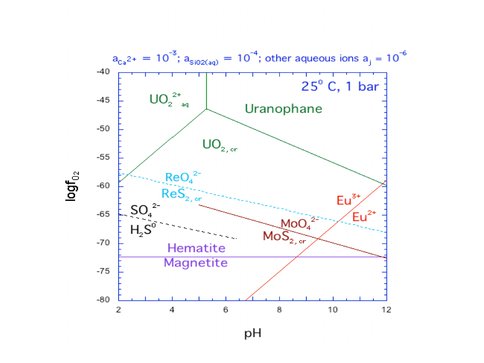2009 Annual Science Report
 Carnegie Institution of Washington
Reporting | JUL 2008 – AUG 2009
Carnegie Institution of Washington
Reporting | JUL 2008 – AUG 2009
Project 3: The Origin, Evolution, and Volatile Inventories of Terrestrial Planets
Project Summary
The origin and Sustenance of life on Earth strongly depends on the fact that volatile elements H-C-O-N where retained in sufficient abundance to sustain an ocean-atmosphere. The research in this project involves studies of how terrestrial planets form, why differences exist among the terrestrial planets, how volatiles behave deep within the Earth, and how volatiles and life influence the large and small scale composition of the near surface Earth.
Project Progress
Task 3.1 Planet Formation
Co-investigator Chambers, in collaboration with Dr Jeff Cuzzi, NASA Ames Research Center, has worked on a new model for planetesimal formation, the earliest stage of planet formation. During this stage, micron-sized dust grains commonly observed in protoplanetary disks, evolve into 1-1000 km diameter planetesimals, which are the precursor to later stages of planet formation including habitable planets. Conventional models for planetesimal formation have encountered severe difficulties in turbulent protoplanetary disks, and yet disks are widely believed to be turbulent. In the new model for planetesimal formation, mm-sized particles are concentrated into stagnant regions between turbulent eddies. Occasionally, large gravitationally bound clumps of particles form, which can then shrink to form planetesimals directly. The recent work by Co-I Chambers shows that the new mechanism is viable under plausible disk conditions, converting much of the available dust into roughly 100-km diameter planetesimals on a timescale of a few million years. These results will be used to provide input for Chambers’ models for the later oligarchic and post-oligarchic stages of formation of habitable planets.
Co-investigator Chambers has also developed a new analytic model for the evolution of a protoplanetary disk for use in planet-formation simulations. The new model provides the approximate temperature and surface density of material at any point in space and time for a protoplanetary disk subject to heating from viscous accretion of gas and radiation from the central star. Being analytic in nature, the new model involves very modest computational overhead, yet it represents a significant improvement over models currently used in most simulations of planet formation. In addition to the planetesimal formation model described above, the new disk evolution model will be incorporated into Co-I Chambers’ existing models for the formation of habitable planets.
Task 3.2. The Inner Solar System: Constraints from Mercury and Mars
CoI Solomon is the PI of the Messenger mission to Mercury. CoI Nittler is a coinvestigator on the Messenger Team. As part of this project Solomon and Nittler are integrating the information derived from the Messenger mission into a better understanding of processes of forming small, embryo-sized inner planets: where Mercury is about 5% of an Earth mass, and Mars at about 10%. That the bulk compositions, volatile abundances, magmatic histories, and magnetic field histories differ so strongly on these two bodies demonstrates the strongly stochastic nature of the planet-building process and probably some dependence on solar distance. Because all of these aspects of planetary evolution affect the spatial extent and temporal duration of zones of habitability at the planetary surface and within the shallow planetary subsurface, an improved understanding of the profound differences in the make-up and evolution of these two similar-size planets should illuminate the general nature of planetary habitability on smaller Earth-like planets, including those in other planetary systems. For both Mars and Mercury, recent spacecraft observations make such a comparison particularly timely. The ongoing Mars Odyssey, Mars Express, Mars Exploration Rover, and Mars Reconnaissance Orbiter missions continue to build the spectacular data sets from imaging and geochemical and geophysical remote sensing, and the Phoenix mission last year augmented our understanding of water and other volatiles at high Martian latitudes. The MESSENGER mission completed its three flybys of Mercury in 2008 and 2009, and an entire year of orbital observations is planned for 2011-2012. The broad goal of this task is a comparative evaluation of bulk composition, volatile inventory, magmatic history, and core dynamo history on Mars and Mercury, with a focus on aspects of those processes (water availability and circulation, organic material inventory, internal energy, magnetospheric shielding) most strongly relevant to habitability in space and time.
The MESSENGER flybys of Mercury provided an abundance of new information pertinent to this task on the geological history, magnetic field, and volatile budget of the innermost planet. MESSENGER images provided evidence for widespread volcanism, and candidate sites for volcanic centers were identified. Newly imaged lobate scarps and other tectonic landforms confirmed that Mercury contracted globally in response to interior cooling. The ~1500-km-diameter Caloris basin, viewed in its entirety for the first time by MESSENGER, was the site of numerous volcanic centers and widespread contractional and extensional deformation. Smooth plains interior and exterior to the basin are demonstrably younger than the basin-forming event. Other large impact basins similarly provided major foci for volcanism and deformation. This focusing can be understood because basin formation amplified magma production at depth by the removal of overburden pressure and the emplacement of impact energy as heat, and also changed the lithospheric stress state by removing pre-existing stress within the basin interior and modifying stress within a damage zone that extended to several basin radii. The latter processes favored magma ascent and plains formation and affected the style and timing of basin deformation.
Reflectance and color imaging observations by MESSENGER provided fresh support for earlier inferences that Mercury’s surface material consists dominantly of iron-poor, calcium-magnesium silicates with an admixture of spectrally neutral opaque minerals. MESSENGER revealed the presence of surface-derived Mg and Ca in Mercury’s anti-sunward tail and documented strongly differing distributions of neutral Mg, Ca, and Na in the nightside exosphere, the result of different combinations of time-variable source, transfer, and loss processes. The nearly global observations of Mercury surface units distinguishable by color and composition enforce the importance of the largely volcanic smooth plains, which occupy ~40% of the surface area, and of low-reflectance material, occupying ~15% of the surface area and primarily in deposits excavated by impact, consistent with having formed at depth. MESSENGER images have documented examples of volcanic centers surrounded by material interpreted to be pyroclastic deposits. The implied magmatic contents of candidate volatiles indicate that Mercury’s accretion included the incorporation of volatile-rich planetesimals or embryos formed farther from the Sun and that some of those volatiles were preserved during whatever processes imparted to Mercury its anomalously high ratio of metal to silicate.
MESSENGER showed that Mercury’s internal magnetic field is dominantly dipolar with a vector moment closely aligned with the spin axis, and no evidence for crustal magnetic anomalies has been found to date. Both results support the inference that Mercury’s magnetic field is the product of a dynamo in the planet’s fluid outer core. MESSENGER also demonstrated that under southward interplanetary magnetic field (IMF) Mercury’s magnetosphere is characterized by magnetic reconnection at rates ~10 times typical at Earth. The magnetosphere–solar wind interaction under such conditions can provide pathways for direct impact of energetic solar wind ions onto Mercury’s surface.
In supporting theoretical work, Postdoctoral Associate Natalia Gómez-Pérez has shown that because Mercury’s internal magnetic field is weak, the interaction of the planet’s magnetosphere with the IMF may determine the internal dynamics and the overall behavior of the liquid core. In particular, regimes of stable dipolar and multipolar reversing dynamo magnetic fields known for isolated systems may be significantly changed by the action of external magnetic field sources. For models appropriate to Mercury, relatively weak external background fields (as low as 2% of the undisturbed core-mantle boundary surface average field strength) may change the energy balance and alter the regime in which natural dynamos operate.
In work led by Postdoctoral Associate Thomas Ruedas, new numerical models for the thermochemical evolution of the mantle of Mars have been initiated. We combined a parameterized model of composition and thermoelastic properties of mantle material with a two-dimensional, anelastic, compressible convection and melting algorithm in a spherical annulus geometry. Results of the models may be compared with chemical and geophysical observations provided by spacecraft missions to Mars. Some models reproduce observed surface concentrations of K and Th and yield crustal thicknesses around 100 km, depths for ancient Curie temperatures for magnetite and hematite between 50 and 100 km, and mechanical lithosphere thicknesses that have increased from less than 50 km at ~3.8 Ga to 150-250 km now. Generally, models with a Mg# of about 75, radionuclide contents similar to those of standard cosmochemical models, and a large core tend to explain observations best. However, the present models indicate that convection is strongly layered and that no long-lived, whole-mantle plumes exist. Under these model assumptions, the existence of Tharsis and Elysium cannot be explained as sustained sites of upwelling from the core-mantle boundary.
Task 3.3 CHON elements in Terrestrial Planetary Interiors
CoIs Goncharov and Hemley have focused their research on the topic of phase diagram at the conditions of high-pressure and high-temperature, which is related to “The Origin, evolution and volatile inventories of terrestrial planets” and more specifically to “Are CHON elements sequestered in planetary interiors?”. Specifically, they have used Raman/laser heating systems at the Geophysical Laboratory and laser heating Diamond Anvil Systems located at National Synchrotron facilities to determine the phase diagram of nitrogen at high pressures and temperatures such as are encountered deep within Planetary interiors (Fig. 3.1). They have also been studying Chemical reactivity of methane under upper-mantle conditions specifically addressing the question whether hydrocarbons can also be produced from abiogenic precursor molecules under the high pressure, high-temperature conditions characteristic of the upper mantle. Methane when subjected to pressures higher than 2 GPa, and to temperatures in the range of 1000–1500 K, partially reacts to form saturated hydrocarbons containing 2–4 carbons (ethane, propane and butane) and molecular hydrogen and graphite (Fig. 3.2). Evidentlly hydrocarbons heavier than methane can be produced by abiogenic processes in the upper mantle (Fig. 3.3). CoIs Goncharov and Hemley have also used x-ray diffraction to determine the structure factor of water along its melting line to a static pressure of 57 GPa (570 kbar) and a temperature of more than 1500 K, conditions which correspond to the lower mantle of the Earth, and the interiors of Neptune and Uranus up to a depth of 7000 km. The results of these studies may suggest that an extended two-phase region could occur in planetary processes involving the adiabatic compression of water. Finally, CoIs Goncharov and Hemley have carried out a systematic investigation of the solid-solid phase transitions, melting behavior, and chemical reactivity of CO2 at pressures of 15-70 GPa and temperatures up to 2500 K where it is observed that molecular CO2 melts to a molecular fluid up to 34 GPa and approximately 1770 K, where it meets a solid-solid phase line to form a triple point (Fig. 3.5). Examination of decarbonation reactions of subducted magnesite (and calcite) in the Earth’s lower mantle reveals that decarbonation produces diamond and fluid oxygen, which in turn significantly affects the redox state of the Mantle, increasing local oxygen fugacity by several orders of magnitude.
Over the past year CoI Mysen has focused on the solubility and solution behavior of reduced species in the COH and NOH systems in model Na2O-SiO2 melts in the 1-2.5 GPa pressure range at upper mantle temperatures and with hydrogen fugacity ranging from those defined by the hematite-magnetite + H2O [fH2(HM)] to iron wüstite ]H2O [fH2(IW)] oxygen buffers. This silicate system was used as a convenient structural for natural silicate melts where the degree of melt polymerization is of principal importance. Mysen has found that methane (CH4) solubility in melts can reach nearly 0.5 wt % at IW redox conditions. The solubility doubles in melt composition ranges from that of andesite to basalt melt compositions in the 1-2.5 GPa pressure range and 1400˚C. Methane solubility in Na2O-SiO2 model melt compositions is not significantly pressure-dependent. H-1 MAS NMR, in collaboration with PI Cody and Raman spectra of CH4-saturated quenched melts indicate that methane is dissolved as molecular CH4 and C≡C-H (acetylene) groups. The acetylene groups are linked to oxygen and not directly to Si. The C≡C-H /CH4 ratio is positive correlated with Na/Si (=NBO/Si) of the melts. The ∂13C of carbon in methane-saturated melts was measured by CoI Fogel and was shown to vary by ~14 ‰ depending on the composition of these melts. Nitrogen solubility in haploandesite melts varies of a factor of 2-4 in the oxygen fugacity range encountered in the Earth’s silicate mantle and ranges from about 1 to about 5 mol % calculated as N at typical upper mantle pressure, temperature and redox conditions. Nitrogen solution mechanisms vary with fH2 where nitrogen is observed in the form of N2, NH2/ins> complexes and molecular NH3 in the melts.
Task 3.4 Primary Carbon in Martian meteorites and terrestrial analogues
CoI Steele and collaborators have continued to study a range of martian meteorites for the distribution of carbon phases. Analysis has concentrated on Chassigny, Zagami and DaG 476. So far Macromolecular carbon (MMC) has been found within inclusions in all 3 meteorites. In all cases the MMC is associated with a spinel phase, except for instance in a large melt inclusion in Chassigny where the MMC seems to be associated with sulfide phases. Software updates to the Raman microscope have enabled high resolution 3-D scans to be implemented on suitable samples. Depth profiling of inclusions in DaG 476 have yielded excellent 3-D contextual data for the association of MMC with spinel. Furthermore, studies analyzing peak parameters of the MMC in comparison with other carbonaceous meteorites are ongoing. Comparison of the D and G band parameters of MMC in Martian and carbonaceous meteorites, Svalbard xenoliths and several terrestrial fossils show a trend where the fossil materials cluster at certain G band peak centres / full width half max values for the G band. This data is preliminary but may lead to insights on the use of Raman spectroscopy to determine biotic or abiotically formed MMC. Carbon isotope analysis of Zagami, DaG 476, NWA 998, and SAU 130, by a modified step combustion protocol are underway. Initial results on the Martian meteorite NWA 998 indicate a carbon content of 68ppm and ~δ13C – 22‰. The carbon isotopic value is similar to that seen in other studies however, the concentration is an order of magnitude higher than previously reported. Working with CoI Mysen, Steele and CIW-NAI Post Doc McCubbin are employing diamond anvil experiments to study the nature of carbon phases at high temperature and pressure under different oxygen fugacities. Preliminary data sets are currently being analyzed but show a trend of more reduced carbon species with lower fO2. Piston cylinder experiments in collaboration with CoI Mysen designed to investigate the formation of MMC under high temperature / pressure conditions are being planned for the very near future.
Task 3.5 Terrestrial Evolution
As part of this task undertaken by CoI Shirey is to extend surface geological processes seen on Earth’s continents to the 150 km depths of their continental lithospheric mantle keels. This is being done by using the age systematics (as determined by the radiometric Re-Os system) of sulfide mineral inclusions in ancient diamonds that have been erupted by recent volcanism of kimberlite melt. These macro diamonds have grown and resided in the mantle keels to continents and are the oldest, deepest minerals found on Earth; they provide a unique record of deep continental lithospheric processes. There are two expected outcomes of this endeavor: 1) by intimately relating continental geology to specific episodes of diamond formation it will possible to identify the source of diamond-forming fluids and 2) the diamond ages and sulfide compositions will lead to a better understanding of the role subcontinental lithosphere plays in the evolution of stable continents. Realizing these outcomes is important because understanding how diamond-forming fluids access the continental lithosphere has potential importance to understanding the source of the crustal fluids that support subsurface microbial ecosystems. In addition, the tectonic processes that deliver these fluids play a role in making continents emergent surfaces that then create new substrates for life.
The Kaapvaal-Zimbabwe craton of southern Africa (Fig. 3.6) is the only ancient continental terrane whose commercial diamond mining operations have yielded enough diamonds over a wide enough geographic area to permit a pattern of diamond ages to be correlated with regional-scale continental geology. The center of the Kaapvaal craton is marked by a N-S suture (Fig. 3.6). Studies of crustal geology show that this suture is the trace of the collision and subsequent welding of two continental blocks by westward-dippping subduction 2.9 billion years ago. West of this suture, the oldest and by far the most abundant age obtained for eclogitic sulfide inclusions in diamonds is 2.9 billion years. East of this suture, few if any sulfides exist of 2.9 billion year age and most sulfides are younger by more than a billion years. This supports a model whereby subduction underthrusting of oceanic lithosphere, converted to eclogite by high pressure, released its C-O-H-S fluids to the base of the overlying lithospheric mantle. They percolated upward and crystallized diamonds only in that portion of the keel that overlay the subducted slabs. Since the eastern block does not reside above subducted lithosphere, the base of the lithosphere does not receive fluids and few diamonds of the 2.9 billion age were formed.
The Kaapvaal craton was subsequently subject to subduction around its margins and magmatism from below in the Proterozoic. Diamond ages record these events, again documenting the access of fluids to the lithsopheric mantle at depths of hundreds of kilometers. The two northwestern diamond localities on the Kaapvaal-Zimbabwe craton, Orapa and Jwaneng (red open symbols in Fig 3.6), are closest to the Magondi metamorphic belt. They show diamond populations with the largest range in age, including the original craton amalgamation age and three episodes at 2, 1.5 and 1 billion years ago (Fig 3.7). The latter ages are likely related to the orogenesis that produced the Magondi belt. It is quite significant that no other localities on the craton show more that 1 or two age pulses in their sulfide inclusions and that both Orapa and Jwaneng show the same age pulses. Both of these mines are prolific diamond producers and have abundant sulfides perhaps a result of being closest to the source of the diamond-forming fluids.
Sulfides in diamonds from two of the kimberlites towards the northeast side of the craton (Premier and Venetia) have ages that reflect subcratonic magmatism related to the 2.05 billion year old Bushveld complex. Sulfide-bearing diamonds, as part of the larger gem diamond population are much rarer here perhaps because they are farther from the subduction source of fluids. Four eclogitic sulfide inclusions from Venetia regress to give a 2.05 billion age, in direct confirmation that the diamonds in this region grew at the time the Bushveld complex was intruded. Eclogitic inclusions from both Premier and Venetia have very elevated initial Os isotopic compositions that span the Bushveld complex range and indicate that the fluids that formed the diamonds and the magmas that formed the Bushveld share similar source characteristics.
In general subduction is the fundamental plate tectonic process by which the continental crust has grown with time. It is logical then to extend subduction as far back in Earth history as possible in order to explore its role in producing stable, compositionally differentiated continental surfaces. Such surfaces are topographically 5 km higher than oceanic lithospheric surfaces and become new settings for subaerial life. Their creation presents a classic example of how planetary differentiation produces new types of habitat. Furthermore, subduction is the primary mechanism by which volatiles are recycled into the mantle and eventually provide deep fluids that could have harbored life within the crust. Our work will continue to use the diamond age evidence the explore the continent forming process from the bottom up and to synthesize available trace element and isotopic evidence from the literature to establish the onset of the subduction part of the plate tectonic cycle.
Co-investigator Hazen and coworkers continue to investigate “mineral evolution,” which is a new way to frame mineralogy in an geohistorical context. The central premise of mineral evolution is that the geo- and biospheres have coevolved through a sequence of deterministic and stochastic events that result in the diversification of the mineral kingdom through Earth history. An important implication of this model is that different terrestrial planets and moons achieve different stages of mineral evolution. The initial exploration of the mineral evolution concept was published in November 2008. Subsequent efforts have focused on specific mineral groups. This past year Hazen and collaborators have focused on the uranium and thorium bearing minerals. The origins and near-surface distributions of the approximately 250 known uranium and/or thorium minerals elucidate principles of mineral evolution. This history can be divided into four phases. The first, from ~4.5 to 3.5 Ga, involved successive concentrations of uranium and thorium from their initial uniform trace distribution into magmatic-related fluids from which the minerals, uraninite (UO2), thorianite (ThO2) and coffinite (USiO4), precipitated in the crust. The second period, from ~3.5 to 2.2 Ga, saw the formation of large low-grade concentrations of detrital uraninite (containing several weight percent Th) in the Witwatersrand-type quartz-pebble conglomerates deposited in a highly anoxic fluvial environment. Earth’s third phase of uranium mineral evolution followed the Great Oxidation Event (GOE) at ~2.2 Ga and thus was mediated indirectly by biologic activity. Most uraninite deposited during this phase was low in Th and precipitated from saline and oxidizing hydrothermal solutions (100 to 300°C) transporting UO22+-chloride complexes. During this phase, most uranyl minerals would have been able to form in the O2-bearing near-surface environment for the first time through weathering processes. The fourth phase of uranium mineralization began approximately 400 million years ago, as the rise of land plants led to non-marine organic-rich sediments that promoted new sandstone-type ore deposits (Fig. 3.8). The near-surface mineralogy of uranium and thorium provide a measure of a planet’s geotectonic and geobiological history.
In collaboration with Edward Grew (University of Maine) Co-investigator Hazen has begun a detailed examination of beryllium mineral evolution. Beryllium is a quintessential crustal element: it is highly enriched in the upper continental crust compared to other reservoirs, i.e., 3.0-3.1 ppm vs. 1.0-1.7 ppm in the lower crust and 60 ppb in primitive mantle. Beryllium minerals result from a variety of processes that concentrate Be and mix it with other constituents under conditions that favor their combining in a variety of compounds. Diversity in Be mineral assemblages appears to require special circumstances. For example, diversity in granitic pegmatites does not depend only on degree of fractionation, as some highly fractionated pegmatites are reported to contain no Be minerals, whereas less fractionated pegmatites contain several, e.g., beryl plus three secondary Be silicates derived from its alteration in central Sweden (Fig. 3.9). The latter example emphasizes the role of alteration and reworking of pre-existing Be minerals, commonly beryl, to create a host of secondary minerals. Co-investigator Hazen has begun research on the evolution of Hg, Br, I, and P minerals, as well as clay minerals. We continue to focus on the effects of the Great Oxidation Event, and on mineralogical evidence for the oxidation state of Earth’s near-surface environment during the Archean Eon.
Figure 3.1. Figure 3.1 – Proposed high P – T phase diagram of nitrogen.
Figure 3.2. Figure 3.2 – Raman spectra of quenched products illustrating the formation of heavier hydrocarbons (ethane, propane and butane) after the laser heating.
Figure 3.3. Figure 3.3 – Pressure–temperature range corresponding to hydrocarbon formation in laser-heating experiments in comparison with the model oceanic (60mWm-2) and shield (40mWm-2) geotherms and the methane melting line.
Figure 3.4. Figure 3.4 – The phase diagram of water and the enthalpy of fusion ΔHF.
Figure 3.5. Figure 3.5 – Phase boundaries in CO2 at high pressures and temperatures obtained in this study. Error – shows maximum error bar of pressure and temperature measurements. Thick grey curve – average isentropic temperature profile of the Earth’s mantle with Anderson-Gruneisen parameter equal to 5.
Figure 3.6. Figure 3.6 – Sketch map of the Kaapvaal-Zimbabwe craton showing the position of key tectonic, magmatic, and mantle keel components in relation to the age and isotopic grouping of diamond inclusions. The craton boundary is shown in black, the suture between its two halves in black with teeth, marginal subduction in brown with teeth. Symbols show diamond mines that yielded samples for study.
Figure 3.7. Figure 3.7 – Re-Os isochron diagram showing 4 distinct age groupings of sulfide inclusions in diamonds from the diamonds mine of Orapa (colors) and Jwaneng (black). Table shows the agreement between ages obtained on sulfide inclusions on individual diamonds and silicate inclusions from previous studies in the literature.
Figure 3.8. Figure 3.8 – Dark-colored uranium minerals form roll-front type ore deposits when U-bearing solutions contact reducing, organic-rich material in terrestrial sediments. Such deposits formed only in the past 400 million years, since the rise of land plants. (3 meters wide)
Figure 3.9. Figure 3.9 – The diversification of beryllium minerals versus time illustrates principles of mineral evolution. No Be minerals are known from before about 3 Ga, owing to the long times required to select and concentrate the rare element.
Figure 3.10. Figure 3.10 – A wide range of geochemical and mineralogical evidence points to an effective log(fO2) prior to 2.4 Ga close to the hematite-magnetite buffer of -72.
Publications
-
Anderson, B. J., AcuñA, M. H., Korth, H., Slavin, J. A., Uno, H., Johnson, C. L., … McNutt, R. L. (2009). The Magnetic Field of Mercury. Space Sci Rev, 152(1-4), 307–339. doi:10.1007/s11214-009-9544-3
-
Baker, D. N., Odstrcil, D., Anderson, B. J., Arge, C. N., Benna, M., Gloeckler, G., … Zurbuchen, T. H. (2009). Space environment of Mercury at the time of the first MESSENGER flyby: Solar wind and interplanetary magnetic field modeling of upstream conditions. Journal of Geophysical Research: Space Physics, 114(A10), n/a–n/a. doi:10.1029/2009ja014287
-
Blewett, D. T., Robinson, M. S., Denevi, B. W., Gillis-Davis, J. J., Head, J. W., Solomon, S. C., … McClintock, W. E. (2009). Multispectral images of Mercury from the first MESSENGER flyby: Analysis of global and regional color trends. Earth and Planetary Science Letters, 285(3-4), 272–282. doi:10.1016/j.epsl.2009.02.021
-
Boardsen, S. A., Slavin, J. A., Anderson, B. J., Korth, H., & Solomon, S. C. (2009). Comparison of ultra-low-frequency waves at Mercury under northward and southward IMF. Geophysical Research Letters, 36(18), None. doi:10.1029/2009gl039525
-
Ernst, C. M., Murchie, S. L., Barnouin, O. S., Robinson, M. S., Denevi, B. W., Blewett, D. T., … Roberts, J. H. (2010). Exposure of spectrally distinct material by impact craters on Mercury: Implications for global stratigraphy. Icarus, 209(1), 210–223. doi:10.1016/j.icarus.2010.05.022
-
Fassett, C. I., Head, J. W., Blewett, D. T., Chapman, C. R., Dickson, J. L., Murchie, S. L., … Watters, T. R. (2009). Caloris impact basin: Exterior geomorphology, stratigraphy, morphometry, radial sculpture, and smooth plains deposits. Earth and Planetary Science Letters, 285(3-4), 297–308. doi:10.1016/j.epsl.2009.05.022
-
Freed, A. M., Solomon, S. C., Watters, T. R., Phillips, R. J., & Zuber, M. T. (2009). Could Pantheon Fossae be the result of the Apollodorus crater-forming impact within the Caloris basin, Mercury?. Earth and Planetary Science Letters, 285(3-4), 320–327. doi:10.1016/j.epsl.2009.02.038
-
Gillis-Davis, J. J., Blewett, D. T., Gaskell, R. W., Denevi, B. W., Robinson, M. S., Strom, R. G., … Sprague, A. L. (2009). Pit-floor craters on Mercury: Evidence of near-surface igneous activity. Earth and Planetary Science Letters, 285(3-4), 243–250. doi:10.1016/j.epsl.2009.05.023
-
Gómez-Pérez, N., & Wicht, J. (2010). Behavior of planetary dynamos under the influence of external magnetic fields: Application to Mercury and Ganymede. Icarus, 209(1), 53–62. doi:10.1016/j.icarus.2010.04.006
-
Gómez-Pérez, N., Heimpel, M., & Wicht, J. (2010). Effects of a radially varying electrical conductivity on 3D numerical dynamos. Physics of the Earth and Planetary Interiors, 181(1-2), 42–53. doi:10.1016/j.pepi.2010.03.006
-
Head, J. W., Murchie, S. L., Prockter, L. M., Solomon, S. C., Chapman, C. R., Strom, R. G., … Kerber, L. (2009). Volcanism on Mercury: Evidence from the first MESSENGER flyby for extrusive and explosive activity and the volcanic origin of plains. Earth and Planetary Science Letters, 285(3-4), 227–242. doi:10.1016/j.epsl.2009.03.007
-
Head, J. W., Murchie, S. L., Prockter, L. M., Solomon, S. C., Strom, R. G., Chapman, C. R., … Ostrach, L. R. (2009). Evidence for intrusive activity on Mercury from the first MESSENGER flyby. Earth and Planetary Science Letters, 285(3-4), 251–262. doi:10.1016/j.epsl.2009.03.008
-
Kerber, L., Head, J. W., Solomon, S. C., Murchie, S. L., Blewett, D. T., & Wilson, L. (2009). Explosive volcanic eruptions on Mercury: Eruption conditions, magma volatile content, and implications for interior volatile abundances. Earth and Planetary Science Letters, 285(3-4), 263–271. doi:10.1016/j.epsl.2009.04.037
-
Lawrence, D. J., Feldman, W. C., Goldsten, J. O., McCoy, T. J., Blewett, D. T., Boynton, W. V., … Solomon, S. C. (2010). Identification and measurement of neutron-absorbing elements on Mercury’s surface. Icarus, 209(1), 195–209. doi:10.1016/j.icarus.2010.04.005
-
Mohit, P. S., Johnson, C. L., Barnouin-Jha, O., Zuber, M. T., & Solomon, S. C. (2009). Shallow basins on Mercury: Evidence of relaxation?. Earth and Planetary Science Letters, 285(3-4), 355–363. doi:10.1016/j.epsl.2009.04.023
-
Purucker, M. E., Sabaka, T. J., Solomon, S. C., Anderson, B. J., Korth, H., Zuber, M. T., & Neumann, G. A. (2009). Mercury’s internal magnetic field: Constraints on large- and small-scale fields of crustal origin. Earth and Planetary Science Letters, 285(3-4), 340–346. doi:10.1016/j.epsl.2008.12.017
-
Slavin, J. A., Acuna, M. H., Anderson, B. J., Baker, D. N., Benna, M., Boardsen, S. A., … Zurbuchen, T. H. (2009). MESSENGER Observations of Magnetic Reconnection in Mercury’s Magnetosphere. Science, 324(5927), 606–610. doi:10.1126/science.1172011
-
Smith, D. E., Zuber, M. T., Phillips, R. J., Solomon, S. C., Neumann, G. A., Lemoine, F. G., … Oberst, J. (2010). The equatorial shape and gravity field of Mercury from MESSENGER flybys 1 and 2. Icarus, 209(1), 88–100. doi:10.1016/j.icarus.2010.04.007
-
Uno, H., Johnson, C. L., Anderson, B. J., Korth, H., & Solomon, S. C. (2009). Modeling Mercury’s internal magnetic field with smooth inversions. Earth and Planetary Science Letters, 285(3-4), 328–339. doi:10.1016/j.epsl.2009.02.032
-
Watters, T. R., Murchie, S. L., Robinson, M. S., Solomon, S. C., Denevi, B. W., André, S. L., & Head, J. W. (2009). Emplacement and tectonic deformation of smooth plains in the Caloris basin, Mercury. Earth and Planetary Science Letters, 285(3-4), 309–319. doi:10.1016/j.epsl.2009.03.040
-
Watters, T. R., Solomon, S. C., Robinson, M. S., Head, J. W., André, S. L., Hauck, S. A., & Murchie, S. L. (2009). The tectonics of Mercury: The view after MESSENGER’s first flyby. Earth and Planetary Science Letters, 285(3-4), 283–296. doi:10.1016/j.epsl.2009.01.025
-
Zuber, M. T., Montési, L. G. J., Farmer, G. T., Hauck, S. A., Andreas Ritzer, J., Phillips, R. J., … Johnson, C. L. (2010). Accommodation of lithospheric shortening on Mercury from altimetric profiles of ridges and lobate scarps measured during MESSENGER flybys 1 and 2. Icarus, 209(1), 247–255. doi:10.1016/j.icarus.2010.02.026
-
- Barnouin-Jha, O.S., Zuber, M.T., Oberst, J., Preusker, F., Smith, D.E., Neumann, G.A., Solomon, S.C., Hauck, S.A., Phillips, R.J., Head, J.W., Prockter, L.M. & Robinson, M.S. (2009). Assessing the relationship between crater depth and diameter on Mercury with topographic measurements by MESSENGER [Abstract]. 40th Lunar and Planetary Science Conference.
- Blewett , D.T., Robinson, M.S., Denevi, B.W., Murchie, S.L., Domingue, D.L., Izenberg, N.R., Sprague, A.L., McClintock, W.E., Holsclaw, G.M., Vilas, F., Gillis-Davis, J.J., Lawrence, D.J., Feldman, W.C., Evans, L.G., Rhodes, E.A. & Solomon, S.C. (2009). The iron content of Mercury’s surface: A review of the evidence. Programme with Abstracts, The Surface Composition of Mercury from Ultraviolet-Visible-Infrared Spectroscopy: State of the Art and Future Strategies. Università degli Studi di Parma, Parma, Italy.
- Blewett, D.T., Kerber, L., Head, J.W., Denevi, B.W., Robinson, M.S., Murchie, S.L., Gillis-Davis, J.J. & Solomon, S.C. (2009). Mercury pyroclastics: Color, morphology, and volatile content [Abstract]. 40th Lunar and Planetary Science Conference.
- Chapman, C.R., Solomon, S.C., McNutt, R.L., Anderson, B.J., Evans, L.G., Gold, R.E., Head, J.W., Krimigis, S.M., Murchie, S.L., Nittler, L.R., Phillips, R.J., Slavin, J.A., Zuber, M.T. & Team, M. (2009). Mercury after three MESSENGER flybys [Abstract]. Bulletin of the American Astronomical Society, 41: 1008.
- D’Amore, M., Helbert, J., Maturilli, A., Izenberg, N.R., Sprague, A.L., Holsclaw, G.M., Head III, J.W., McClintock, W.E. & Solomon, S.C. (2009). Compositional units along the M1 and M2 MASCS ground track from a principal component analysis. Programme with Abstracts, The Surface Composition of Mercury from Ultraviolet-Visible-Infrared Spectroscopy: State of the Art and Future Strategies. Università degli Studi di Parma, Parma, Italy.
- D’Amore, M., Helbert, J., Maturilli, A., Izenberg, N.R., Sprague, A.L., Holsclaw, G.M., Head III, J.W., McClintock, W.E. & Solomon, S.C. (2009). Compositional units along the M1 and M2 MASCS ground tracks from principal component and clustering analyses. Europlanet Research Infrastructure, European Planetary Science Congress. Potsdam, Germany.
- Denevi, B.W., Robinson, M.S., Blewett, D.T., Domingue, D.L., Head, J.W., McCoy, T.J., McNutt, R.L., Murchie, S.L. & Solomon, S.C. (2009). MESSENGER global color observations: Implications for the composition and evolution of Mercury’s crust [Abstract]. 40th Lunar and Planetary Science Conference.
- Denevi, B.W., Robinson, M.S., Solomon, S.C., Murchie, S.L., Blewett , D.T., Domingue, D.L., McCoy, T.J., Ernst, C.M., Head III, J.W., Watters, T.R. & Chabot, N.L. (2009). A global perspective from MESSENGER and Mariner 10 on the composition and evolution of Mercury’s crust. Programme with Abstracts, The Surface Composition of Mercury from Ultraviolet-Visible-Infrared Spectroscopy: State of the Art and Future Strategies. Università degli Studi di Parma, Parma, Italy.
- Freed, A.M., Solomon, S.C., Watters, T.R., Phillips, R.J. & Zuber, M.T. (2009). Could Pantheon Fossae be the result of the Apollodorus crater-forming impact within the Caloris basin, Mercury? [Abstract]. 40th Lunar and Planetary Science Conference.
- Gillis-Davis, J.J., Blewett, D.T., Denevi, B.W., Robinson, M.S., Solomon, S.C., Strom, R.G. & Team, M. (2009). Pit-Floor Craters on Mercury: Characteristics and modes of formation [Abstract]. 40th Lunar and Planetary Science Conference.
- Gómez-Pérez, N. & Wicht, J. (2009). Magnetic field at Mercury: Effects of external sources on planetary dynamos [Abstract]. 40th Lunar and Planetary Science.
- Head, J.W., Solomon, S.C., McNutt, R.L., Blewett, D.T., Chapman, C.R., Domingue, D.L., Gillis-Davis, J.J., Hawkins, S.E., Helbert, J., Holsclaw, G.M., Izenberg, N.R., McClintock, W.E., Merline, W.J., Murchie, S.L., Phillips, R.J., Prockter, L.M., Robinson, M.S., Denevi, B.W., Sprague, A.L., Strom, R.G., Vilas, F., Watters, T.R. & Zuber, M.T. (2009). The MESSENGER mission to Mercury: New insights into geological processes and evolution from the first two encounters [Abstract]. 40th Lunar and Planetary Science Conference.
- Helbert, J., D’Amore, M., Maturilli, A., Izenberg, N.R., Sprague, A.L., Holsclaw, G.M., Head, J.W., McClintock, W.E., Blewett, D.T. & Solomon, S.C. (2009). Compositional units on Mercury along MESSENGER ground tracks from principal component analysis of spectral observations [Abstract]. 40th Lunar and Planetary Science Conference.
- Izenberg, N.R., McClintock, W.E., Holsclaw, G.M., Blewett , D.T., Domingue, D.L., Donaldson Hanna, K.L., Jensen, D.A., Kochte, M.C., Lankton, M.R., Sprague, A.L., Vilas, F., Solomon, S.C., Robinson, M.S. & Helbert, J. (2009). Resolved ultraviolet to infrared reflectance spectroscopy of Mercury from the first two MESSENGER flybys. Programme with Abstracts, The Surface Composition of Mercury from Ultraviolet-Visible-Infrared Spectroscopy: State of the Art and Future Strategies. Università degli Studi di Parma, Parma, Italy.
- Izenberg, N.R., McClintock, W.E., Holsclaw, G.M., Blewett, D.T., Helbert, J., Solomon, S.C. & Team, M. (2009). Resolved ultraviolet to infrared reflectance spectroscopy of Mercury from the second MESSENGER flyby [Abstract]. 40th Lunar and Planetary Science Conference.
- Johnson, C.L., Uno, H., Purucker, M.E., Anderson, B.J., Korth, H., Slavin, J.A. & Solomon, S.C. (2009). Mercury’s magnetic field: Assessing the effects of external fields on internal field models [Abstract]. 40th Lunar and Planetary Science Conference.
- Killen, R.M., Bida, T.A., Potter, A.E., McClintock, W.E., Bradley, E.T., Vervack, R.J., Anderson, C.M., Morgan, T.H., Sprague, A.L. & Solomon, S.C. (2009). Metallic Species in Mercury’s Exosphere Observed by MESSENGER, the Keck I and McMath-Pierce Telescopes. Bulletin of the American Astronomical Society, 41: 1134.
- Lawrence, D.J., Feldman, W.C., Goldsten, J.O. & Solomon, S.C. (2009). Identification of neutron absorbing elements on Mercury’s surface using MESSENGER neutron data [Abstract]. 40th Lunar and Planetary Science Conference.
- Preusker, F., Oberst, J., Phillips, R.J., Watters, T.R., Head III, J.W., Zuber, M.T. & Solomon, S.C. (2009). Digital terrain models from MESSENGER stereo images [Abstract]. Results from Current Missions, International Society for Photogrammetry and Remote Sensing (ISPRS) Working Group IV/7, Planetary Mapping and Databases. Berlin, Germany.
- Prockter, L.M., Barnouin-Jha, O., Solomon, S.C., Chapman, C.R., Denevi, B.W., Head III, J.W., Watters, T.R., Blewett , D.T. & Gillis-Davis, J. (2009). Mercury’s Raditladi basin: A puzzling example of extensional tectonics in an unusually young impact feature. Europlanet Infrastructure, European Planetary Science Congress. Potsdam, Germany.
- Prockter, L.M., Barnouin-Jha, O., Solomon, S.C., Head III, J.W., Fassett, C.I., Watters, T.R., Murchie, S.L., Robinson, M.S., Chapman, C.R., Strom, R.G. & McNutt, J.,.R.L. (2009). Impact cratering on mercury: Historical pespective and new views from MESSENGER. Programme with Abstracts, The Surface Composition of Mercury from Ultraviolet-Visible-Infrared Spectroscopy: State of the Art and Future Strategies. Università degli Studi di Parma, Parma, Italy.
- Prockter, L.M., Watters, T.R., Chapman, C.R., Denevi, B.W., Head, J.W., Solomon, S.C., Murchie, S.L., Barnouin-Jha, O.S., Robinson, M.S., Blewett, D.T. & Gillis-Davis, J. (2009). The curious case of Raditladi basin [Abstract]. 40th Lunar and Planetary Science Conference.
- Purucker, M.E., Johnson, C.L., Anderson, B.J., Korth, H., Uno, H., Blewett, D.T., Sabaka, T.J., Solomon, S.C. & Head, J.W. (2009). Mercury’s internal magnetic field from MESSENGER [Abstract]. 40th Lunar and Planetary Science Conference.
- Ruedas, T., Tackley, P.J. & Solomon, S.C. (2009). Water, melting, and convection in the Martian mantle [Abstract]. 40th Lunar and Planetary Science Conference.
- Smith, D.E., Zuber, M.T., Phillips, R.J., Solomon, S.C., Lemoine, F.G., Neumann, G.A., Head, J.W. & Torrence, M.H. (2009). Does Mercury have lunar-like mascons? [Abstract]. 40th Lunar and Planetary Science Conference.
- Solomon, S.C., Freed, A.M., Hauck, S.A., Head, J.W., Kerber, L., Phillips, R.J., Robinson, M.S., Watters, T.R. & Zuber, M.T. (2009). MESSENGER’s newly global perspective on Mercury: Some implications for interior evolution [Abstract]. 40th Lunar and Planetary Science Conference.
- Solomon, S.C., McClintock, W.E., Anderson, B.J., Domingue, D.L., Evans, L.G., Gold, R.E., Head III, J.W., Krimigis, S.M., Murchie, S.L., Nittler, L.R., Phillips, R.J., Slavin, J.A. & Zuber, M.T. (2009). MESSENGER’s first and second flybys of Mercury: A scientific overview. Europlanet Infrastructure, European Planetary Science Congress. Potsdam, Germany.
- Solomon, S.C., McNutt, J.,.R.L., Anderson, B.J., Domingue, D.L., Evans, L.G., Gold, R.E., Head III, J.W., Krimigis, S.M., Murchie, S.L., Nittler, L.R., Phillips, R.J., Slavin, J.A., Zuber, M.T. & Team, t.M. (2009). MESSENGER’s first and secondflybys of Mercury: A Scientific overview. Programme with Abstracts, The Surface Composition of Mercury from Ultraviolet-Visible-Infrared Spetroscopy: State of the Art and Future Strategies.
- Watters, T.R., Murchie, S.L., Robinson, M.S., Head, J.W., Chapman, C.R., Solomon, S.C., Denevi, B.W., André, S.L., Fassett, C.I. & Team, M. (2009). A newly discovered impact basin on Mercury revealed by MESSENGER [Abstract]. 40th Lunar and Planetary Science Conference.
- Zuber, M.T., Farmer, G.T., Hauck, S.A., Ritzer, J.A., Phillips, R.J., Solomon, S.C., Smith, D.E., Head, J.W., Neumann, G.A., Robinson, M.S., Watters, T.R., Johnson, C.L., Oberst, J., Barnouin-Jha, O. & McNutt, R.L. (2009). Observations of ridges and lobate scarps on Mercury from MESSENGER altimetry and imaging and implications for lithospheric strain accommodation [Abstract]. 40th Lunar and Planetary Science Conference.
- Zuber, M.T., Smith, D.E., Phillips, R.J., Solomon, S.C. & Oberst, J. (2009). The equatorial shape, topography, and gravity of Mercury from the MESSENGER flybys of 2008. Europlanet Infrastructure, European Planetary Science Congress. Potsdam, Germany.
- Zurbuchen, T.H., Raines, J.M., Gloeckler, G., Slavin, J.A., Krimigis, S.M., Killen, R.M., Sprague, A.L., McNutt, R.L. & Solomon, S.C. (2009). First ion plasma measurements in the Mercury magnetosphere [Abstract]. 40th Lunar and Planetary Science Conference.
-
PROJECT INVESTIGATORS:
-
PROJECT MEMBERS:
George Cody
Project Investigator
Marilyn Fogel
Co-Investigator
Douglas Rumble
Co-Investigator
Penny Morrill
Collaborator
Natalia Gomez-Perez
Postdoc
Francis McCubbin
Postdoc
Thomas Reudas
Postdoc
-
RELATED OBJECTIVES:
Objective 1.1
Formation and evolution of habitable planets.
Objective 3.1
Sources of prebiotic materials and catalysts
Objective 4.1
Earth's early biosphere.
